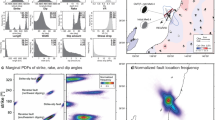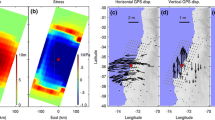Abstract
Mixture density networks (MDNs) are a class of neural network algorithms in the Bayesian framework that can invert for parameters and estimate the parameter uncertainties at the same time. We test MDNs by inverting the fault geometric parameters in a synthetic test with Okada’s model and demonstrate the efficiency and robustness of the model. To further describe the MDNs algorithm, we invert regional static GPS displacement data for the 2013 Ms7.0 Lushan Earthquake in China to obtain the fault geometric parameters. The inverted geometric parameters, which are in the form of distributions, agree well with the published solutions for this event once the 99.7% confidence interval are taken into account. The 99.7% confidence intervals of the strike and dip angles are [\(187.5^\circ\), \(220.4^\circ\)] and [\(20.76^\circ\), \(49.76^\circ\)], respectively. To demonstrate the applicability of the inverted geometric parameters, we invert the slip distribution of the Lushan earthquake with the inverted parameters and GPS displacements. From the slip distributions considering the distributions of the parameters, we obtain the 99.7% confidence intervals of the magnitude Mw, maximum slip and depth of maximum slip, which are [6.51, 6.65], [0.30, 0.74] m and [9.43, 13.61] km, respectively.











Similar content being viewed by others
References
Anderson, K., & Segall, P. (2013). Bayesian inversion of data from effusive volcanic eruption using physics-based models: Application to Mount St. Helens 2004–2008. Journal of Geophysical Research, 118, 2017–2037.
Arnadottir, T., et al. (1992). Resolving the discrepancy between geodetic and seismic fault models for the 1989 Loma Prieta, California. Bulletin of the Seismological Society of America, 82(5), 2248–2255.
Atzori, S., et al. (2009). Finite fault inversion of DInSAR coseismic displacement of the 2009 L’Aquila earthquake (central Italy). Geophysical Research Letters, 36, L15305.
Bagnardi, M., & Hooper, A. (2018). Inversion of surface deformation data for rapid estimates of source parameters and uncertainties: A Bayesian approach. Geochemistry, Geophysics, Geosystems, 19, 2194–2211.
Bishop, C. M. (1994). Mixture density networks. Cambridge: MIT Press.
DeVries, M. R., et al. (2017). Enabling large-scale viscoelastic calculations via neural network acceleration. Geophysical Research Letters, 44, 2662–2669.
DeVries, M. R., et al. (2018). Deep learning of aftershock patterns following large earthquakes. Nature, 560, 632–634.
Elliott, J. R., et al. (2016). The role of space-based observation in understanding and responding to active tectonics and earthquakes. Nature Communications, 7(1), 1–16.
Ergintav, S., et al. (2009). Seven years of postseismic deformation following the 1999, M = 7.4 and M = 7.2, Izmit-Düzce, Turkey earthquake sequence. Geophysical Research Letters, 114, B07403.
Fukuda, J., & Johnson, K. M. (2008). A fully bayesian inversion for spatial distribution of fault slip with objective smoothing. Bulletin of the Seismological Society of America, 98(3), 1128–1146.
Fukuda, J., & Johnson, K. M. (2010). Mixed linear-non-linear inversion of crustal deformation data: Bayesian inference of model, weighting and regularization parameters. Geophysical Jounral International, 184, 1441–1458.
Guillaumes, A. B. (2017). Mixture Density Networks for distribution and uncertainty. Master’s Thesis, Universitat de Barcelona.
Goodfellow, I., et al. (2016). Deep learning. Cambridge: MIT Press.
Huang, Y., et al. (2019). Fault geometry and slip distribution of the 2013 Mw 6.6 Lushan earthquake in China constrained by GPS, InSAR, leveling, and strong motion data. Journal of Geophysical Research, 124, 7341–7353.
Jiang, Z. S., et al. (2014). GPS constrained coseismic source and slip distribution of the 2013 Mw6.6 Lushan, China, earthquake and its tectonic implications. Geophysical Research Letters, 412, 407–413.
Käufl, P., et al. (2014). A framework for fast probabilistic centroid-moment-tensor determination—inversion of regional static displacement measurements. Geophysical Jounral International, 196, 1676–1693.
Käufl, P., et al. (2016). Solving probabilistic inverse problems rapidly with prior samples. Geophysical Jounral International, 205, 1710–1728.
Käufl, P., et al. (2016). Probabilistic point source inversion of strong-motion data in 3-D media using pattern recognition: A case study for the 2008 Mw 5.4 Chino Hills earthquake. Geophysical Research Letters, 43, 8492–8498.
Kim, A., & Dreger, D. S. (2008). Rupture process of the 2004 Parkfield earthquake from near-fault seismic waveform and geodetic records. Journal of Geophysical Research, 113.
Kingma, D. P., & Ba, J. L. (2015). Adam: A method for stochastic optimization. In The 4th International Conference on Learning Representations (ICLR).
Lomax, A., & Snieder, R. (1995). Identifying sets of acceptable solutions to non-linear, geophysical inverse problems which have complicated misfit functions. Nonlinear Processes in Geophysics, 2, 222–227.
Mackay, D. J. (2003). Information theory, inference and learning algorithms. Cambridge: Cambridge University Press.
Marchandon, M., et al. (2018). Fault geometry and slip distribution at depth of the 1997 Mw7.2 Zirkuh earthquake: Contribution of near-field displacement data. Journal of Geophysical Research, 1232, 1904–1924.
McLachlan, G. J., & Basford, K. E. (1988). Mixture Models: Inference and Applications to Clustering Applications to Clustering. Statistics: Textbooks and Monographs 84, Marcel Dekker.
Menke, W. (2012). Geophysical data analysis: Discrete inverse theory (MATLAB Edition) (3rd ed.). Amsterdam: Elsevier.
Minson, S. E., et al. (2013). Bayesian inversion for finite fault earthquake source models I-theory and algorithm. Geophysical Jounral International, 194, 1701–1726.
Najafabadi, M. M. et al. (2015). Deep learning applications and challenges in big data analytics. Journal of Big data, 1.
Okada, Y. (1985). Surface deformation due to shear and tensile faults in a half space. Bulletin of the Seismological Society of America, 75(4), 1135–1154.
O’Toole, T. B., & Woodhouse, J. H. (2011). Numerically stable computation of complete synthetic seismograms including the static displacement in plane layered media. Geophysical Jounral International, 187(3), 1516–1536.
Perol, T., et al. (2018). Convolutional neural network for earthquake detection and location. Science Advances, 4, e1700578.
Ripperger, J., & Mai, P. M. (2004). Fast computation of static stress changes on 2D fault from final slip distributions. Geophysical Research Letters, 31, L18610.
Robert, M. F. (1961). Transmission of information: A statistical theory of communication. Cambridge: The MIT Press.
Stein, R. S. (2003). Earthquake conversations. New York: Scientific American.
Sambridge, M., & Mosegaard, K. (2002). Monte Carlo methods in geophysical inverse problems. Reviews of Geophysics, 40(3), 1–3.
Stramondo, S., et al. (2011). Seismic source quantitative parameters retrieval from InSAR Data and neural networks. IEEE Transactions on Geoscience and Remote Sensing, 49(1), 96–104.
Sudhaus, H., & Jónsson, S. (2009). Improved source modelling through combined use of InSAR and GPS under consideration of correlated data errors: Application to the June 2000 Kleifarvatn earthquake. Iceland. Geophysical Jounral International, 172(2), 389–404.
Tape, W., & Tape, C. (2012). A geometric setting for moment tensors. Geophysical Jounral International, 190(1), 476–498.
Venetis, I. E., et al. (2020). Multi-variable inversion using exhaustive grid search and high-performance GPU processing: A new perspective. Geophysical Jounral International, 221, 905–927.
Wang, K. L., & He, J. H. (2008). Effects of frictional behavior and geometry of subduction fault on coseismic seafloor deformation. Bulletin of the Seismological Society of America, 98(2), 571–579.
Wang, W. M., et al. (2013). Preliminary Result for rupture process of Apr. 20, 2013 Lushan earthquake, Sichuan China. Chinese Journal of Geophysical, 56(4), 1412–1417.
Wright, T. J., et al. (2003). Source model for the Mw 6.7 23 October 2002, Nenana Mountain Earthquake (Alaska) from InSAR. Geophysical Research Letters, 30, L1861018.
Xu, C. J., Shen, W. B., & Chao, D. B. (2006). Geophysical geodesy principles and methods. Wuhan: Wuhan University Press.
Xu, C. J., et al. (2016). Construction and Geodesy slip inversion analysis of 2013 Ms 7.0 Lushan in China Earthquake’s Curved Fault Model. Geomatic and Information Science of Wuhan University, 42(11), 1665–1671.
Xu, C. J., Deng, C. Y., & Zhou, L. X. (2017). Coseismic Slip distribution inversion method based on the variance component estimation. Geomatic and Information Science of Wuhan University, 41(1), 37–44.
Zhang, Y., et al. (2013). Rupture of the Lushan 4.20 earthquake and preliminary analysis on the disaster-causing mechanism. Chinese Journal of Geophysical, 56, 1408–1411.
Zhao, C. P., et al. (2013). Source rupture process of Lushan Ms 7.0 earthquake, Sichuan, China and its tectonic implication. Chinese Science Bulletin, 58(20), 3444–3450.
Acknowledgements
This research is co-funded by the National Key Research and Development Plan of China under Grand No. 2018YFC1503604, the National Natural Science Foundation of China under Grand No. 41721003, and the DAAD Thematic Network Project (DAAD 57421148).
Author information
Authors and Affiliations
Corresponding author
Additional information
Publisher's Note
Springer Nature remains neutral with regard to jurisdictional claims in published maps and institutional affiliations.
Rights and permissions
About this article
Cite this article
Zhou, L., Xu, C. Inversion of Fault Geometric Parameters Based on Mixture Density Networks: A Case Study of the 2013 Ms7.0 Lushan Earthquake in China. Pure Appl. Geophys. 178, 21–38 (2021). https://doi.org/10.1007/s00024-020-02639-1
Received:
Revised:
Accepted:
Published:
Issue Date:
DOI: https://doi.org/10.1007/s00024-020-02639-1




